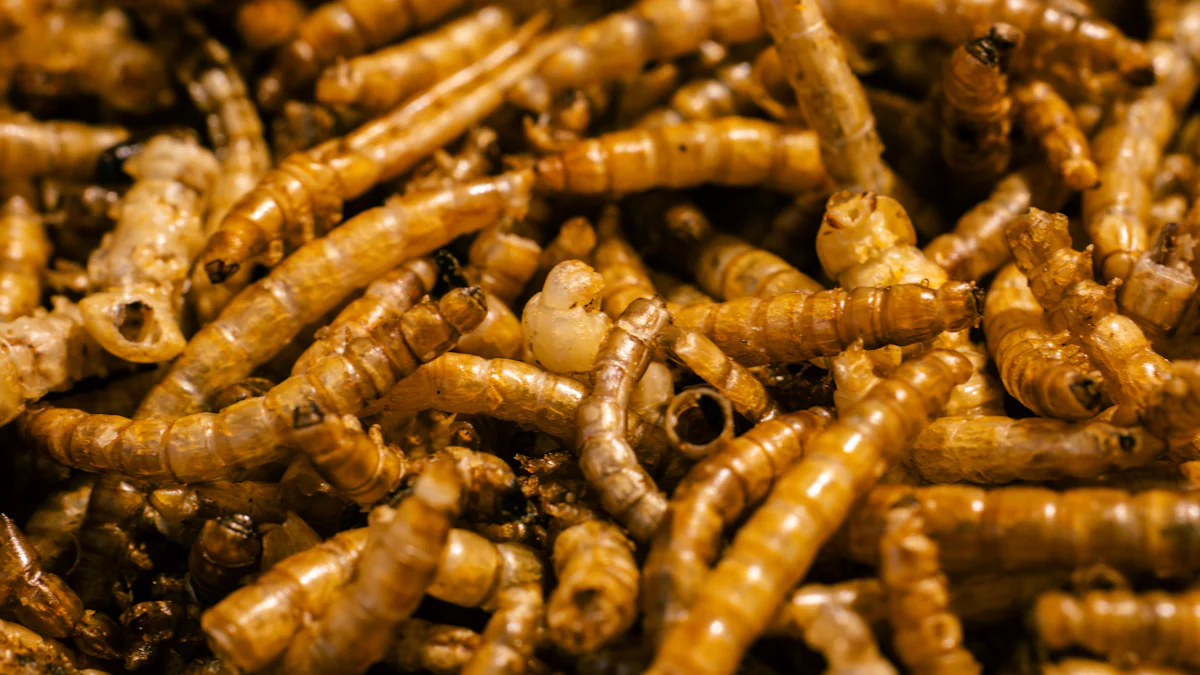
If you’re looking for a reliable bait, dried mealworms for fishing bait are a fantastic choice. Packed with protein and natural oils, they mimic the nutrition of a fish’s natural prey. Their hard exoskeleton makes them durable on hooks, while their rich nutrients attract fish seeking energy-packed meals. They’re practical and effective!
Key Takeaways
- Dried mealworms are healthy bait, full of protein and fats.
- They last a long time and are easy to store. This makes them great for quick fishing trips without worrying about spoilage.
- Soaking mealworms in water makes them softer and more like live bait. This can help you catch more fish.
Why Dried Mealworms Work as Fishing Bait
Nutritional Benefits for Fish
Fish are naturally drawn to food that’s packed with nutrients, and dried mealworms deliver just that. They’re loaded with protein, which helps fish grow and stay healthy. Carnivorous fish, in particular, love high-protein meals, making dried mealworms an irresistible option. But that’s not all—they also contain fats and carbohydrates, giving fish the energy they need to stay active.
What’s more, mealworms are a natural food source for many fish species. They even enhance the vibrant colors of ornamental fish, which is a bonus if you’re fishing in ponds or lakes with decorative species. Plus, their rich mix of vitamins and minerals, like iron, calcium, and magnesium, supports overall fish health. When you use dried mealworms for fishing bait, you’re offering fish a meal they can’t refuse.
Durability and Hooking Advantages
One of the biggest perks of dried mealworms is their durability. Unlike live bait, they don’t spoil quickly and can be stored for long periods without losing their effectiveness. This makes them perfect for spontaneous fishing trips or for anglers who don’t fish often.
When it comes to hooking, dried mealworms hold up better than many other baits. Their hard exoskeleton keeps them intact, even after being cast into the water. If you rehydrate them before use, they become plump and easier to thread onto a hook. You can even use tools like a bait needle to make the process smoother. Once on the hook, they stay secure, giving you more time to focus on catching fish instead of constantly replacing bait.
Versatility in Different Fishing Conditions
Dried mealworms for fishing bait work in almost any situation. Whether you’re float fishing, bottom fishing, or using a feeder rig, they adapt easily. You can use them straight from the package, rehydrate them, or mix them with other baits for added appeal.
Their versatility doesn’t stop there. They’re effective in both freshwater and saltwater environments, attracting a wide range of fish species. From calm lakes to fast-moving rivers, dried mealworms perform well. They’re a reliable choice no matter where or how you like to fish.
Preparing Dried Mealworms for Fishing
Rehydrating for Enhanced Appeal
If you want to make your dried mealworms even more tempting for fish, rehydrating them is a great trick. Soaking them in water softens their texture, making them look and feel more like live bait. Fish are more likely to bite when the bait feels natural.
To rehydrate, simply place the mealworms in a bowl of water for a few minutes. Be careful not to overdo it, though. You want them soft but not mushy. Over-soaking can make them fall apart, which makes hooking them harder. This simple step can give you an edge, especially when fishing in areas where fish are picky about their food.
Using Them Directly from the Package
Sometimes, you just want to keep things simple. Using dried mealworms straight from the package is not only convenient but also effective. Here’s why:
- Long Shelf Life: They stay fresh for months, so you can always have them ready for a last-minute fishing trip.
- Cost-Effectiveness: They’re affordable and can be used multiple times without needing constant replacement.
- Ease of Use: No prep work is needed. Just grab them and go.
- Versatility: Whether you’re fishing in freshwater or saltwater, they work like a charm.
Mealworms have several pros that make them a go-to bait for many anglers. First, their hard exoskeleton and high protein content make them highly attractive and nutritious for fish. They are also durable and can survive for extended periods on the hook and in storage.
Proper Storage for Longevity
To get the most out of your dried mealworms, proper storage is key. Keep them in a cool, dry place to maintain their quality. If you want to extend their shelf life even further, refrigeration is your best bet.
Storing mealworms in the fridge slows down their natural processes, keeping them usable for up to ten weeks. Without refrigeration, they’re good for about three weeks.
Avoid exposing them to high temperatures, as this can speed up spoilage. By storing them correctly, you’ll always have reliable bait on hand when you need it.
Using Dried Mealworms While Fishing
Hooking Techniques to Prevent Breaking
Hooking dried mealworms properly ensures they stay intact and effective. Here’s a simple step-by-step guide to help you:
- Thread one or two mealworms onto a small hook. This keeps the bait secure and prevents it from breaking.
- Make sure the hook is well-hidden. A natural presentation increases your chances of a bite.
- Adjust the weight and depth of your line based on your fishing method.
Another technique involves using a lively mealworm. Insert the hook through its head to secure it, then thread it onto the hook so it curls naturally. This method works well because it mimics the movement of live prey, making it irresistible to fish.
Combining Mealworms with Other Baits
Pairing dried mealworms with other baits can boost your success. You can combine them with worms, maggots, or even artificial lures. For example, adding a mealworm to a soft plastic lure creates a unique texture and scent that fish find appealing.
You can also use mealworms as part of a bait mix. Sprinkle them into ground bait or chum to attract fish to your spot. This strategy works especially well in areas with high fish activity. Experiment with different combinations to see what works best for your target species.
Ideal Fishing Spots for Mealworms
Dried mealworms for fishing bait perform best in areas where fish naturally gather. Look for spots with natural cover and structures, such as submerged logs, overhanging trees, or grassy banks. These areas provide shelter and hunting grounds for fish.
Shorelines, docks, and piers in ponds and lakes are also excellent choices. Fish often linger near these spots, making them prime locations for casting your line. Rocky areas can be another great option, especially for species that prefer hiding in crevices.
By choosing the right spot, you’ll increase your chances of landing a catch. Keep an eye out for signs of fish activity, like ripples or jumping fish, to guide your decision.
Fish Attracted to Dried Mealworms
Common Freshwater Species
Dried mealworms for fishing bait are a hit with many freshwater fish. You’ll find that species like bluegill, crappie, perch, trout, and bass can’t resist them. Bluegill, for example, love the small size and movement of mealworms. Trout, known for their appetite for insects, eagerly go after them too. If you’re targeting bass, both largemouth and smallmouth varieties are drawn to mealworms, especially in shallow waters. Even catfish, those opportunistic feeders, will take a bite when other food is scarce.
These fish are common in lakes, rivers, and ponds, making mealworms a versatile choice. Whether you’re fishing for sport or just for fun, you’ll likely reel in one of these species with mealworms on your hook.
Saltwater Species That Respond Well
You might think dried mealworms are only for freshwater fishing, but they work surprisingly well in saltwater too. Coastal species like snapper, bream, and even small grouper often respond to mealworms. Their high protein content and natural scent make them appealing, even in brackish or salty environments.
If you’re fishing off a pier or near rocky shores, try using mealworms to attract smaller saltwater fish. These fish often gather in these areas, making it easier to test your bait. While they might not replace live shrimp or cut bait for larger species, mealworms are a handy option for smaller catches.
Seasonal Factors to Consider
The time of year can influence how fish respond to mealworms. During warmer months, fish are more active and likely to bite. In spring and summer, species like bluegill and trout are especially eager to feed on insects, making mealworms an excellent choice.
In colder months, fish activity slows down, but that doesn’t mean mealworms won’t work. You’ll just need to adjust your technique. Try fishing in deeper waters where fish tend to gather during winter. Rehydrating your mealworms can also make them more appealing when fish are less aggressive.
By understanding seasonal patterns, you can make the most of your fishing trips and increase your chances of success.
Tips for Success with Dried Mealworms
Selecting High-Quality Mealworms
Choosing the right dried mealworms for fishing bait can make all the difference in your success. High-quality mealworms are packed with nutrients and are versatile enough for various fishing techniques. Here’s a quick guide to help you identify the best ones:
| Characteristic | Description |
|---|---|
| Nutritional Value | High in protein, fats, and carbohydrates, essential for fish growth and attraction. |
| Versatility | Suitable for various fishing techniques and environments, adaptable for different fish species. |
| Ease of Use | Requires minimal preparation and is easy to transport, making it user-friendly. |
| Long Shelf Life | Can be stored for extended periods without spoiling, ideal for spontaneous fishing trips. |
| Cost-Effectiveness | Generally more affordable than live bait, providing multiple uses per package. |
| Environmentally Friendly | Derived from mealworm larvae, which have a lower ecological footprint compared to other baits. |
When shopping, look for mealworms that are plump, evenly dried, and free from discoloration. These traits ensure you’re getting bait that fish will find irresistible.
Adapting Techniques to Fish Behavior
Fish behavior can vary depending on water clarity, temperature, and activity levels. Adapting your approach to these factors can significantly improve your results. Here are some tips:
- Observe how fish are moving and adjust your technique.
- In clear water, use a light line and a small hook for a natural presentation.
- In murky water, focus on the mealworm’s scent and movement. A larger hook and added motion can help.
- During colder months, fish tend to be less active. Slow down your retrieves to match their energy levels.
By paying attention to these details, you’ll increase your chances of landing a catch, no matter the conditions.
Experimenting with Bait Presentation
How you present your bait can make or break your fishing trip. Dried mealworms for fishing bait are incredibly versatile, so don’t be afraid to get creative. Here are some ideas to try:
- Thread one or two mealworms onto a small hook, hiding the hook for a natural look.
- Adjust the weight and depth of your line based on your fishing method, whether it’s bottom fishing, bobber fishing, or fly fishing.
- Use mealworms as a topping for other bait, like worms or artificial lures, to create a unique combination.
- Add mealworms to fishing jigs or ground bait to attract fish to your spot.
Experimenting with these techniques can help you discover what works best for your target species and fishing environment. Don’t hesitate to mix things up—you might just find your new favorite method!
Dried mealworms are a game-changer for anglers. Their long shelf life and versatility make them perfect for any fishing trip. You can use them for float fishing, bottom fishing, or even in saltwater.
With their durability and high protein content, mealworms are a practical, effective bait. Try them—you’ll see the difference!
FAQ
How do dried mealworms compare to live bait?
Dried mealworms are easier to store and last longer. Their hard exoskeleton and high protein content make them just as attractive to fish as live bait.
Can I use dried mealworms in saltwater fishing?
Yes! Saltwater species like snapper and bream respond well to mealworms. Their natural scent and nutrients make them effective even in brackish or salty environments.
What’s the best way to store dried mealworms?
Keep them in a cool, dry place. Refrigeration extends their shelf life up to ten weeks, ensuring they stay fresh and ready for your next trip.


